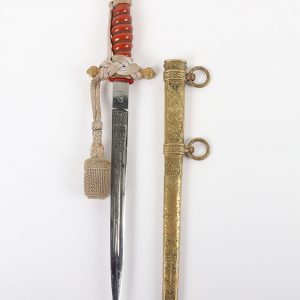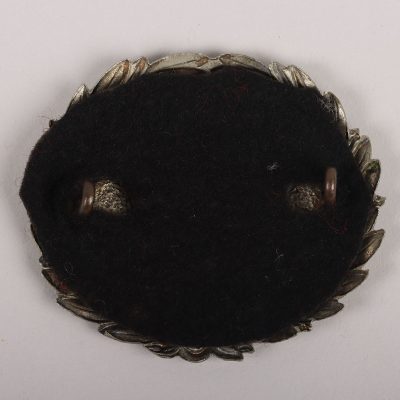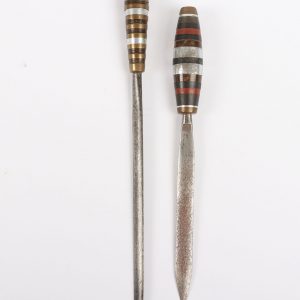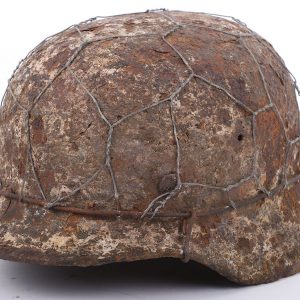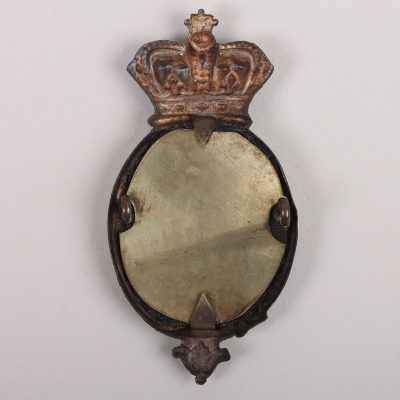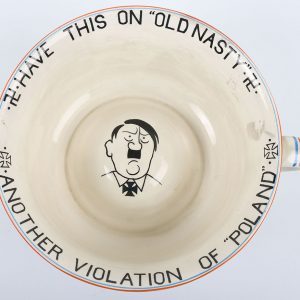Цены, указанные на сайте, могут быть изменены.
Для уточнения актуальных цен свяжитесь с нами или воспользуйтесь формой обратной связи.
Отображение 865–880 из 3607
Фильтры-
#124 – Rare WW2 German Deluxe Pattern Kriegsmarine Officers Dress Dagger by WKC (Лот: 7313)
Ставки принимаются через менеджераRare WW2 German Deluxe Pattern Kriegsmarine Officers Dress Dagger by WKC, superb example of the very rare deluxe model naval officers dagger with deep orange celluloid grip with the original wire binding. Gilt metal eagle pommel top and cross guard. Complete with its original dress portepee / knot in light golden wire with silver fleck. Dagger is complete with the deluxe hand chassed and hammered scabbard. Fine condition double edged blade with the standard etched decoration and makers trademark to the base. The blade measures 25cms, overall 40 ¾ cms. These deluxe pattern scabbards were special order by the particular naval officer from WKC and you can find various types of these, see ‘Exploring the Dress Daggers of the German Navy’ by Thomas T Wittmann pages 371-376 for more information about these specially produced / purchased daggers.
-
#124 – Rare and Historically Important WW2 Special Forces (Special Allied Airborne Reconnaissance Force) Operation Violet Military Medal Grouping Awarded to Sergeant Phillip Potter US Army O.S.S (Лот: 8716)
Ставки принимаются через менеджераRare and Historically Important WW2 Special Forces (Special Allied Airborne Reconnaissance Force) Operation Violet Military Medal Grouping Awarded to Sergeant Phillip Potter US Army O.S.S, George VI Military Medal (M.M) on ribbon with brooch pin, awarded to ‘SJT. P. B. K. POTTER. U.S. ARMY.’ Medal is also accompanied by a grouping of his original cloth insignia, which includes his very rare embroidered special forces (S.F) wing, 2x British airborne parachute qualification wings, parachute qualified ‘light bulb’ sleeve patch, sterling silver US army issue jump wings with pin back fitting and red on khaki ‘AMERICAN FIELD SERVICE’ shoulder title, plus other items of cloth insignia. Also with the grouping is a historically interesting original snapshot photograph album compiled by Sergeant Potter and assuming his brother Alan Potter during WW2. The album begins with images in 1943 when he first joined the services and then moves into basic training before quickly moving him into service in North Africa (Libya), then onto Italy before being moved to France, near Limoges, in summer (August 1944). Album has some excellent images from his time near Limoges, including a bridge blown up with the annotation below, ‘Bridge Blown by Creuse Maquis and Allied Agents’. Excellent large image of him and men from his unit wearing the Special Forces wings above British jump wings, stated ‘Before operations against Jerry in Chateauroux. Summer 1944 American Parachutists’. Image of a castle city of Carcassonne, where he states he met with allied agents. Images of battle damage German weapons, German officer POW’s and a large format image of ‘Allied Agents at ceremony of presentation of Croix de Guerre’. Album then has some pictures from Italy campaign at the same time, Summer 1944, these would appear to be taken by his brother Alan. Then more images in France, before moving back to London before Philip’s posting to the Far East in 1945. Album ends with images in Burma taken by Philip Potter and then a page taken by his brother, still in Italy, with images of Cassino (Monte Cassino). The album is well annotated and many of the images are extremely clear and interesting. Overall a superb grouping including a gallantry medal to a member of a very small Allied Special Forces unit. he recommendation for his Military Medal was by Brigadier J S Nichols D.S.O MC Commander SAARF, ‘HQ and HQ Det OSS, US ARMY Attached SAARF – 11121960 Sgt Philip B K POTTER. Sgt POTTER was the W/T Operator in Captain WARFIELD’s Team, one of the six Recce teams operating under my direct command which were dropped by parachute on the night 25/26 April 1945 near ALTENGRABOW P W CAMP Twenty miles EAST of MADGEBURG and fifteen miles behind the enemy lines. This team was dropped on a belt of trees in an area occupied by a German Division and fifteen miles away from the correct DZ. Sgt Potter recovered his W/T equipment and immediately got into communication with this Headquarters – although in imminent danger of capture by the enemy parties searching the area. Together with his team he then moved twenty miles through German Formations to the original target. During the whole of this time and in spite of the great danger and extreme hardships caused by lack of food, rain and cold, Sgt POTTER maintained his communications with complete success and transmitted valuable information. He also took considerable risks in recharging his batteries by a hand generator whilst surrounded by German Troops. I consider this NCO’s conduct outstanding.’ he Special Allied Airborne Reconnaissance Force (SAARF) was set up by the Supreme Headquarters Allied Expeditionary Force (SHAEF) in February 1945. They were tasked with being dropped behind enemy lines near prisoner of war camps and slave labour camps to report on the conditions and to prevent atrocities being carried out by the retreating German forces etc. Other duties would involve the hunting down of possibly war criminals. The unit was only involved in one Airborne drop before the unit was disbanded. The unit consisted of just 96 Americans, these mostly came from the US equivalent of the SOE, the OSS (Office of Strategic Services) and members of the allied airborne divisions. peration Violet, on 25th April 1945, was the code name for the SAARF operation to drop 6 multi-national teams at three different drop zones, to reach the German Prisoner of War camp XI A, near the village of Altengrabow. At the time the camp held some 60,000 allied prisoners of war. The six 3 person teams were to be parachute in, close to Altengrabow behind the German lines, drop 1 was a British team ‘Erasure’, commanded by SOE veteran Major Phillip Worrall and French team ‘Briefcase’ commanded by Pierre Cambon. Drop zone 2 was British team ‘Pennib’ under Major Forshall and US team ‘Cashbox’ under Captain Brown. The final drop zone, drop zone 3 was US team ‘Pencil’ led by Captain Warfield and French team ‘Sealingwax’. Sergeant Potter, was serving in the US team Pencil, as the wireless operator under Captain Warfield. ach drop zone was allotted one RAF transport aircraft to carry the two teams. The teams left from RAF Airfield Great Dunmow, Essex. The operation did not go smoothly to begin with, as the teams missed the drop zones and the heavy presence of German forces in the area resulted with many of the teams being captured, including the British team ‘Erasure’ and resulted in the men being sent to the prisoner of war camp they were sent to observe, Stalag XI A. British officer Major Worrall requested an interview with camp commandant, Oberst Ochemal. Major Worrall explained the mission of SAARF, and with the war looking like it was lost and the Soviet Russians fast approaching, the camp commander eventually cooperated and allowed the SAARF teams to set up communications with SHAEF. On 3rd May 1945, Major General Robert Macon, US army, sent a convoy of trucks into liberate the allied prisoners of war and transport them west, along with the captured German commander and his men. US trucks were sent in with aid and rations. Due to the time taken from the initial landing on the 25th April, for a deal to be done between German commander and US forces, the Soviet army had advanced and they arrived at the camp on 4th May 1945. The area of the camp had been decided, would be in the Soviet controlled zone, so they tried to force authority in the situation, only allowing POW’s from certain nations to be evacuated, they blocked Polish and Italian prisoners from leaving. On 5th May, Major Worrell was told by the soviet commander he only had two hours for his SAARF team to pack up their equipment and leave the camp and return to western allied lines. The tensions between the western allies and the Soviet command was starting to show as the war drew to its close.
-
#124 – 2nd Administration Battalion Hants Rifle Volunteers Headdress Badge (Лот: 10190)
Аукцион завершенМинимальная цена продажи 60 £ не достигнута2nd Administration Battalion Hants Rifle Volunteers Headdress Badge, white metal die-stamped headdress badge with laurel wreath enclosing seeded centre with voided ‘2 AB H R V 5’. Two lug fittings to the reverse and black cloth backing. Late Rod Flood collection Rod’s collection notes states believed to be Hampshire, possibly also Hertfordshire.
-
#125 – GERMAN WWII M-40 RELIC HELMET SHELL (Лот: 5456)
Ставки принимаются через менеджераGERMAN WWII M-40 RELIC HELMET SHELL, has remnants of white winter paint, this does have a wire net / basket (galvanized) attached to a thicker iron bottom portion, our believe is the wire may have been added at some point, overall this helmet is very rusty, has several holes & some cracks, reasonable for a combat / relic display,
-
#125 – Victorian Royal Guernsey Light Infantry Other Ranks Helmet Plate (Лот: 6028)
Ставки принимаются через менеджераVictorian Royal Guernsey Light Infantry Other Ranks Helmet Plate, fine universal pattern other ranks helmet plate with removable centre. Two loop fittings to the reverse. Accompanied by an other ranks two piece glengarry badge with the brass back plate. (2 items) Late Rod Flood collection.
-
#125 – WW2 German Kriegsmarine Officers Dress Dagger by WKC (Лот: 7314)
Ставки принимаются через менеджераWW2 German Kriegsmarine Officers Dress Dagger by WKC, fine example with white celluloid grip having the original wire binding. Reverse of the grip is finely engraved with the name of the original owner ‘Lohrmann’. Attached to the grip is the original golden bullion officers dress porteppe / knot. Eagle pommel top and cross guard with release button. Housed in its original scabbard which has the deluxe roped ring bands. Fine condition blade which retains much of the original polish and has the standard etched decoration to the centre of both sides of the blade. The blade has WKC makers trademark to the base. The blade measures 25cms, overall 42cms.
-
#125 – Second World War 1940 Distinguished Service Medal for Service on a Converted Fishing Trawler (Лот: 8717)
Ставки принимаются через менеджераSecond World War 1940 Distinguished Service Medal for Service on a Converted Fishing Trawler, Distinguished Service medal, GVI 1st type, impressed naming, ‘WRX.83 W.E. BULLIVANT TEL. H.M.T. EDWARDIAN’ with possible correction to 3 letters of vessel name. Medal on investiture pin and contained in fitted case of issue and accompanied by Buckingham Palace enclosure letter named to ‘Lieutenant (SP) W.E. BULLIVANT D.S.M. R.N.V.R.’ ondon Gazette 4th October 1940 – For good services in H.M. Trawlers when attacked by enemy aircraft: Telegraphist William Edward Bullivant, C/WRX.83, H.M.T. Edwardian.
-
#125 – Scarce Victorian Second Battalion Hants Rifles Shako Badge (Лот: 10191)
Ставки принимаются через менеджераScarce Victorian Second Battalion Hants Rifles Shako Badge, fine example of crowned strap having regimental details. Centre of the badge with strung bugle and Hampshire rose to the centre. Cloth backing to the centre with backing plate on reverse. Two lug fittings. Good overall condition. Late Rod Flood collection.
-
#126 – Scarce WW2 German Kriegsmarine Officers Dress Dagger Distributed by Adolf Braun Berlin (Лот: 7315)
Ставки принимаются через менеджераScarce WW2 German Kriegsmarine Officers Dress Dagger Distributed by Adolf Braun Berlin, standard 2nd model naval officers dagger with eagle pommel, white celluloid grip having wire binding and brass cross guard with press stud release button. Housed in a standard model scabbard with two hanging rings. Plain double edged naval type blade with the distributor mark to the base of the blade. Some dents to the scabbard and cracks to the white celluloid on the grip. Blade 24 ¾ cms, overall 41cms. Adolf Braun, Berlin, was a small distributor of dress daggers which used parts and fittings produced by other dagger makers such as Alcoso. See ‘Exploring the Dress Daggers of the German Navy’ by Thomas T Wittmann, page 301.
